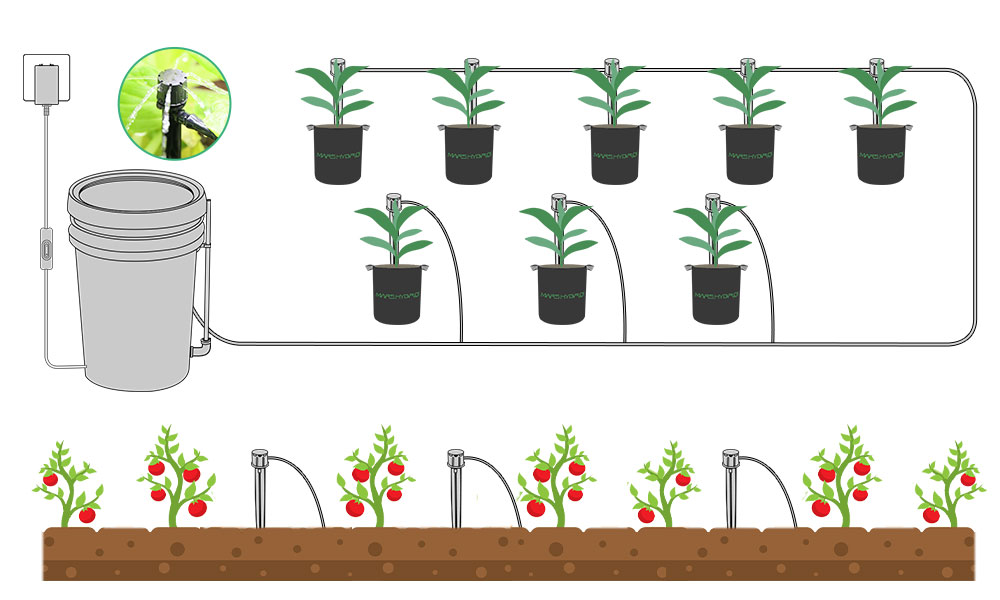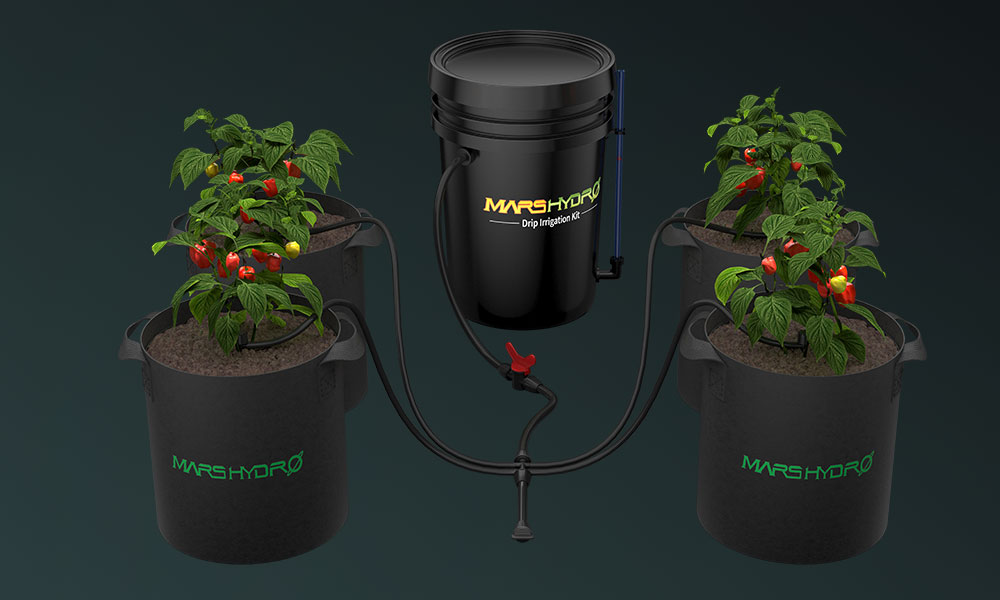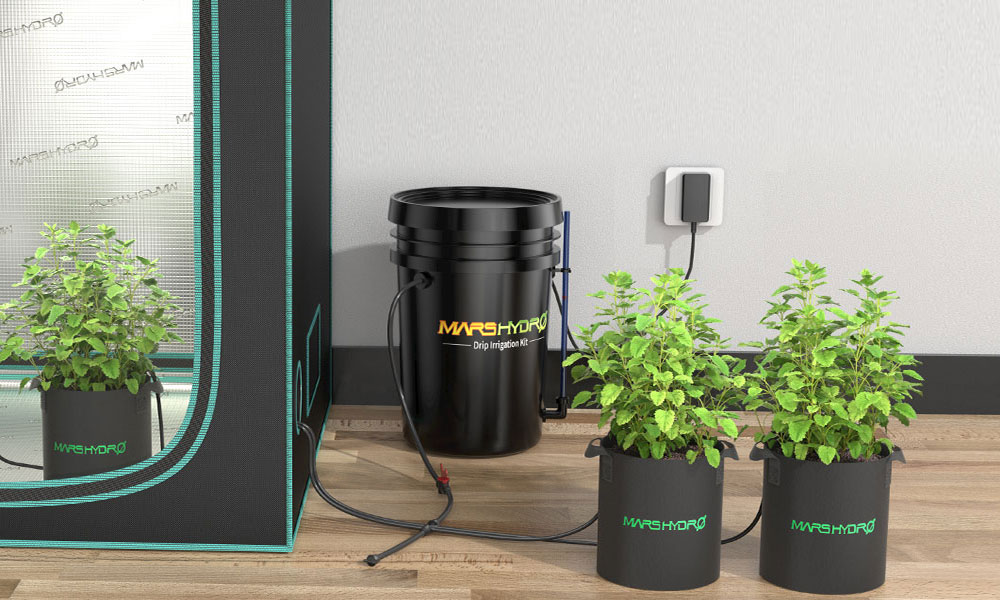Watering is a fundamental aspect of gardening, but it’s crucial to strike the right balance. Overwatering can drown plants, lead to root rot, and waste precious resources, while underwatering can stunt growth and leave plants thirsty. However, drip irrigation offers an intelligent solution by delivering water directly to the root zone, promoting healthy plant development while conserving water.
If you’re an aspiring gardener or someone looking to optimize their watering practices, you’ve come to the right place. In this comprehensive blog, we will delve into the world of drip irrigation—an efficient and precise method of providing water to plants.
What Is Drip Irrigation?
Drip irrigation is an irrigation method that delivers water directly to the plant’s root zone in a controlled and efficient manner. It involves the use of a system of tubes, pumps, and valves to provide a slow and targeted application of water, drop by drop, to the plants.
Besides, drip systems is widely used in various applications, including agriculture, landscaping, gardens, and even for potted plants. It can be adapted to suit different plant types, garden sizes, and water requirements. Overall, drip irrigation is recognized as an efficient, precise, and sustainable method of irrigation, helping conserve water resources while ensuring the optimal health and growth of plants.
The Pros And Cons of Drip Irrigation
Pros of Drip Irrigation:
Water Efficiency: Drip sprinkler system is highly efficient in water usage. It delivers water directly to the plant’s root zone, minimizing evaporation and runoff. This targeted approach reduces water waste significantly compared to other irrigation methods.
Precision Watering: Drip irrigation provides precise control over the amount of water delivered to each plant. By regulating the flow rate and placement of emitters, you can ensure that plants receive the right amount of water they need, preventing overwatering or underwatering.
Improved Plant Health: Delivering water directly to the roots promotes healthier plant growth. It reduces the risk of foliage diseases caused by wet leaves and discourages weed growth by keeping the areas between plants drier.
Reduced Weed Growth: Drip irrigation applies water only to the plant’s root zone, minimizing water contact with the surrounding soil. This helps to suppress weed germination and growth, reducing the need for manual weeding or herbicides.
Time and Labor Savings: Drip irrigation systems can be automated with timers or controllers, allowing you to set specific watering schedules. This saves time and effort compared to manual watering methods, especially for larger gardens or agricultural fields.
Versatility: Drip irrigation can be adapted to various landscapes and plant types. It is suitable for gardens, farms, greenhouses, and even container plants. It can be customized and expanded to accommodate changing needs.
Cons of Drip Irrigation:
Initial Cost: The initial setup cost of a drip irrigation system can be higher than traditional sprinkler systems or manual watering methods. It involves purchasing components such as tubing, emitters, filters, and controllers, which can add to the expense.
System Maintenance: Drip irrigation systems require regular maintenance to ensure proper functioning. Filters need to be cleaned or replaced periodically to prevent clogging, and tubing and emitters should be inspected for any damage or blockages.
System Design and Installation: Designing and installing a drip irrigation system may require some technical knowledge. And proper planning is essential to ensure adequate coverage and proper water distribution to all plants.
How Does Drip Irrigation System Work?

Drip irrigation is a method of watering plants that delivers water directly to the plant’s root zone, minimizing water wastage and improving efficiency. It involves a network of pipes or tubing with small drip emitters, called drippers or micro-sprinklers, strategically placed near the plants. Here’s a step-by-step illustration of how a drip irrigation system works:
Water Bucket: A water bucket, also known as a water reservoir, can be a valuable component in a drip irrigation kit. It allows you to collect and store water from various sources, such as rainwater harvesting or manually filling it from a tap or well. Having a water bucket ensures a readily available water supply for your drip irrigation system. Besides, by using a water bucket, you can mitigate the limitations of the main supply and have an independent water source for your plants.
Water Pump: A water pump helps maintain a consistent and reliable flow of water through the drip irrigation system. This is particularly important for larger systems or areas where water pressure may vary. Consistent water flow ensures that each drip emitter delivers the intended amount of water to the plants, promoting uniform irrigation and healthy plant growth.
Valves: Water valves enable precise control over the flow rate of water in the system. By adjusting the valve, you can increase or decrease the amount of water delivered to specific zones or individual plants. This allows you to tailor the irrigation to the specific water needs of different plants, ensuring they receive the appropriate amount of water for optimal growth.
Water Tubes: Drip tubes are typically made of flexible materials, such as polyethylene or PVC. This flexibility makes them easy to install, maneuver, and adapt to the layout of your garden or field. You can curve, bend, or cut the tubes as needed to fit around obstacles, reach different areas, or accommodate the spacing requirements of your plants. Besides, water tubes help conserve water by delivering water directly to the root zone of the plants. This targeted approach minimizes water loss due to evaporation, runoff, or overspray. And the tubes ensure that water is applied precisely where it is needed, reducing water waste and optimizing water usage.
Elbow Connectors: Elbow connectors enable changes in the direction of the water flow within the system. They provide a 90-degree turn, allowing the irrigation lines to navigate around obstacles, corners, or changes in the layout of the garden or field. And this flexibility ensures that the water lines can be properly routed to reach the desired areas for irrigation.
The Best Drip Irrigation System in 2023
Drip irrigation products have gained significant popularity as efficient and water-conserving methods for irrigating plants, and one notable system in this realm is the Mars Hydro watering drip irrigation system. Designed with the goal of providing optimal irrigation for plants, the Mars Hydro drip irrigation kit has become a top choice for both home gardeners and professional cultivators. With its innovative features and reliable performance, the Mars Hydro watering drip irrigation system stands out as one of the best and most popular options in the market today.
The Mars Hydro watering drip irrigation system offers a range of benefits that make it highly regarded among users. Let’s unlock the secrets together!

Provide All the Components Required by Irrigation with Standard Size
The drip irrigation supplies contain a drip system (2 sizes of tubing and 8 water emitters), a pump (22W, 800L/H), and a bucket (5 gallons). All accessories needed for soil drip irrigation are included, and there are two sizes of water pipes for you to choose, and what is more convenient is that you can also cut the water pipe to the required size according to your needs. Besides, all accessories in the system are of standard size, which is convenient for you to carry out DIY, and you can easily buy replacement components in the market.
Harmless Material Bring You Safe Using Experience
All components in this drip irrigation supplies are made of polypropylene and Polyvinyl Chloride (PVC). Polypropylene products are durable but lightweight, corrosion-resistant and wear-resistant (the bucket in the component is made of this material, and its corrosion-resistant properties determine that it can hold a variety of nutrient solutions); And PVC products are stable, lightweight, and environmentally friendly. They not only ensure the safety of the water supply pipe, but also are harmless to plants and humans, so you can use it with confidence.
Professional Design Make Your Irrigation High-Efficient and Convenient
Larger buckets in the system can hold more water, allowing for longer irrigation sessions or watering multiple plants. However, it’s important to note that the capacity of a water bucket is usually limited compared to pressurized water sources, which may require more frequent refilling. Besides, next to the bucket is a water level indicator tube with a red floating ball on it, so you can clearly see the water level inside the opaque bucket.
Consistently Providing Water for Plants with a Powerful Water Pump
Do you often feel anxious because you cannot take care of your plants when you are busy with work or on a journey? With the drip irrigation system, all problems can be easily solved. Mars Hydro drip irrigation kit features a 22w pump with a maximum flow rate of 800 liters per hour, delivering a constant, steady supply of water to your plants. In addition, a filter is attached to the pump inlet to filter out particles in the water and prevent clogging of the water pipes.
Controllable Water Valves Help You Easy Control the Water Volume
If you would like to set the water output volume of the main water valve according to the watering volume of your plants required, you can only use one valve to control the water volume of eight (or four) sprinklers. In addition, it can meet your other requirements, like each dripper can also control its own water output by turning the knob head.

FAQ
1. How Long to Run Drip Irrigation?
The duration of watering plants with a drip irrigation system will depend on various factors specific to your garden or field. As a general guideline, start by running the drip irrigation system for approximately 30 minutes to 1 hour. Then monitor the soil moisture levels after irrigation to assess how well the water has penetrated the root zone. You can use a soil moisture meter or simply dig a small hole near the plants to check the moisture level. If the soil is adequately moist to a depth of 6 to 12 inches, it indicates that the water has reached the plant roots effectively. Adjust the duration based on the observed soil moisture and plant response. In most cases, it is recommended to water deeply and infrequently, allowing the soil to dry out slightly between watering sessions to promote healthy root growth.
2. What Is the Best Time to Run a Drip Irrigation System?
The best time of day to run a drip irrigation system is typically during the early morning hours. This is because the weather conditions tend to be cooler, and there is less wind and evaporation during this time. Running the system in the early morning allows plants to absorb water before the heat of the day, reducing water loss due to evaporation and ensuring that plants have ample moisture throughout the day.
3. Can I Use Fertilizers or Nutrients with a Drip Irrigation System?
Yes, you can use fertilizers or nutrients with a drip irrigation system. In fact, drip irrigation is an efficient method for delivering fertilizers directly to the root zone of plants, ensuring they receive the necessary nutrients for healthy growth.
Final Thoughts
In conclusion, drip irrigation is an excellent solution for beginners looking to enhance their gardening or cultivation practices. This ultimate guide has provided a comprehensive overview of drip irrigation, covering its benefits, components, and best drip irrigation supplies recommendation.
With the knowledge gained from this blog, beginners are equipped to embark on their drip irrigation journey confidently. By incorporating drip irrigation into their gardening or cultivation practices, they can enjoy efficient water usage, healthier plants, and ultimately, a more productive and sustainable growing experience.


